What is a Proforma Invoice?
‘Pro forma’ or ‘proforma’ is Latin and translates to “for form’s sake, on behalf of” [1]. Today, this word still carries its original meaning when we use it to reference pro forma invoices, which, ironically, aren’t official invoices at all.
This guide answers your questions about what proforma invoices are, how they’re used, and why they’re useful.
What is a proforma invoice?
A proforma invoice is a non-official receipt that’s given to a committed buyer before products or services are supplied. They should look almost identical to the final sales invoice, however, they do not carry the same legal weight as a tax invoice or sales invoice since they are provisional. A more accurate description of a proforma invoice is a quote, or ‘good faith’ agreement between the seller and the customer, used to avoid unexpected charges down the line.
What information should a proforma invoice include?
Merchants send a proforma invoice to customers who have enquired about a particular item. The proforma will include all details and a thorough price breakdown, as well as the terms of the sale. Most proforma invoices will include the following details:
- Your business name and address
- Date of issue
- A description of goods or services (product weight/dimensions)
- Price breakdown per item
- Shipping costs
- Total amount due
- VAT and other surcharges
- Addressee name and address
- Payment terms
- The phrase: "This is not a tax invoice"
Proformas should not include merchant payment details or sequential invoice numbers. They should be clearly labelled as a proforma, and they cannot be used for accounting records or to reclaim VAT since they are not legally binding, and are subject to change.
You can create a proforma invoice the same way you create a final invoice, either with invoicing software or as a document that can be amended and edited later.
What is a proforma invoice used for?
The three main reasons that proforma invoices are issued are to give a cost estimate to the buyer, for international shipping, and to streamline the sales process. Companies that sell large quantities of products at one time, like wholesale suppliers, often issue a proforma invoice to provide clarity to the buyer before the agreed purchase takes place.
Cost estimate
You might create a proforma invoice to give buyers your closest estimate of the final cost price of the sale. There should be a breakdown of each item with VAT included, but you cannot request payment. The proforma can later be used as a final invoice template when details are officially decided and agreed upon.
International shipping
Since they often include details about shipping, packaging, weight, and delivery fees, proforma invoices are often used in the international shipping industry. They help to declare the value of an item, speeding up the customs process [2].
The proforma is usually sent when the customer has committed to the sale, but the final details haven’t been confirmed yet. Once the terms and conditions of the sale are agreed upon and payment is sent, merchants can send the formal invoice and complete the delivery or sale.
When should you send a proforma invoice?
To better understand when you should send a proforma, it’s good to compare their purpose against the purpose of other invoice types.
Sales invoices are issued when requesting payment for the sale of products, or shortly after the sale has been completed. Sales invoices that contain tax and VAT information are also known as tax invoices. These are legally binding tax documents and should be kept in your bookkeeping records.
If you ship internationally, you should issue a commercial invoice. These are used in customers and clearing to attain details of the seller and buyer, the date, and an exact description of the products. This is mainly for tax purposes, and to define the financial value of the goods being sold.
If someone enquires about a product, you might send a quote. The main difference between a quote and a proforma invoice is that the latter is usually issued when the sale is more or less agreed. A quote is more suitable when it’s unclear whether or not the enquirer is definitely interested in the sale.
How do I cancel a proforma?
If the sale falls through and you’ve already issued a proforma invoice, you don’t have to do anything. Since they are not official contracts, and no payment has been made, you can simply discard the proforma.
Simplify business management with a reliable POS system
Financial management is a huge part of running a business, but it doesn’t have to be stressful and time-consuming. By choosing the right financial software for your small business, you can turn your attention to other areas of your business, like operational efficiency and taking care of your customers.
Let your point of sale (POS) system handle things like reviewing sales, bookkeeping, and accounting tasks. Epos Now offers state-of-the-art POS systems for businesses in various industries. We let you choose the tools and insights to help make your business achieve its goals. You can do everything from process transactions and print receipts to take inventory and manage staff.
With Epos Now, you can also:
- Create and send invoices using simple templates and a built-in VAT calculator
- Receive and pay ongoing invoices automatically
- Review profitability reports based on individual product performance, trending items, best and worst sellers, and employee sales
- View sales analyses on profit margin, cash flow, and other expenses
- Access multi-award-winning inventory management systems that sync online sales and in-person sales for the most up-to-date stock levels
- Automate stock purchasing so you never miss a sales opportunity
- Save customer contact details and shopping preferences for more targeted marketing on our CRM system
- Integrate with the business automation apps that are right for your business
- Simplify employee management for more efficient scheduling and payroll




